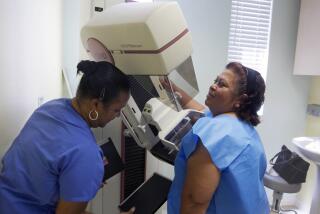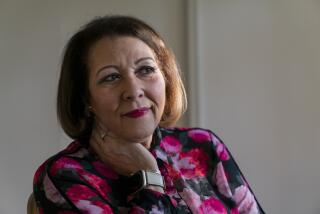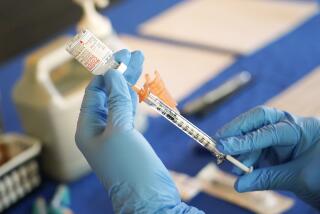Breast cancer testing uproar : A panel’s view that mammograms aren’t needed for women under 50 is attacked.
CHICAGO AND LOS ANGELES — A government panel’s recommendation Monday that women under the age of 50 do not need regular mammograms set off a furious debate about the importance of the routine screening tool, leaving many women confused about how best to protect their health.
In issuing its guidelines, the U.S. Preventive Services Task Force concluded that risk of breast cancer is very low in women age 40 to 50 and that the risk of false positives and complications from biopsies and other invasive procedures is too high for the procedure to be used routinely. The current standard is mammograms every year or two for women 40 and older.
Oncologists were nearly uniform in their disparagement of the guidelines, fearing the loss of a valuable cancer-prevention tool. Women in their 40s account for at least a quarter of breast cancer diagnoses.
“I think it is unfortunate that they came to this conclusion,” said Dr. Angela Sie, director of imaging at the Breast Center at Long Beach Memorial Hospital. “It would be a huge step backwards for women’s health in this country.”
And other groups that issue guidelines about screening and prevention, such as the American Cancer Society, the National Cancer Institute and the American College of Obstetricians and Gynecologists, immediately attacked the federal panel’s conclusion, saying that they would not change their guidelines and would continue to urge women to undergo the tests.
Insurance companies and Medicare administrators, which normally follow the panel’s guidelines closely, said they would continue to pay for the procedure -- although it is not clear how long they can resist the panel’s influence.
The argument is similar to the one recently surrounding men’s screening for prostate cancer. Several studies have suggested that complications from false positives and biopsies in PSA (prostate-specific antigen) screening outweigh the potential benefits of the procedure. The government panel has not produced general guidelines for prostate testing. The cancer society and institute simply recommend that men consult with their doctors about the potential value of the test. That, in effect, is also what the panel is suggesting for mammograms.
The U.S. Preventive Services Task Force was established by the U.S. Public Health Service in 1986 to assess the value of preventive medical techniques, such as mammography. It is now sponsored by the Department of Health and Human Services’ Agency for Healthcare Research and Quality. Its recommendations are closely watched and are generally followed by insurance companies and Medicare, but adherence is not mandatory.
The task force issued the new guidelines, an update to its 2002 recommendations, on Monday in the journal Annals of Internal Medicine.
“No one is saying that women should not be screened in their 40s,” said Dr. Diana Petitti, vice chairwoman of the task force. “We’re saying there needs to be a discussion between women and their doctors.” The task force also advised women age 50 and older to get mammograms every two years instead of every year, and said evidence isn’t sufficient to determine a course of action for women 75 and older.
Breast cancer specialists warned that the new recommendations could undermine advances in detecting and treating breast cancer early. Deaths from breast cancer have dropped 30% since 1990.
Mammography “is one screening test that I recommend unequivocally, and would recommend to any woman 40 and over,” Dr. Otis W. Brawley, chief medical officer of the cancer society, said in a statement. Brawley said the task force concluded that screening 1,300 women in their 50s to save one life is worth it, but that screening 1,900 women in their 40s to save one life is not.
Brawley also noted that 17% of breast cancer deaths in 2006 were among women diagnosed in their 40s.
Added Dr. Len Lichtenfeld, the cancer society’s deputy medical officer: After a review of the evidence, “We see no reason at this point to alter our guidelines.”
Women in their 40s “have more aggressive cancers, have higher risks of death and recurrence, and more difficult cancers to treat,” added Dr. Alice Chung, assistant director of the John Wayne Cancer Institute Breast Center in Santa Monica. “When you are weighing the benefits and risks for them, the benefits clearly outweigh the risks.”
More than 192,000 new cases of breast cancer are expected in the U.S. this year, and 40,000 deaths. Early detection is the best tool to prevent deaths, most oncologists agree.
Evaluating the scientific evidence on the benefits of mammograms has challenged experts for more than 15 years. Eight “gold standard” medical trials have assessed the impact of mammography on breast cancer deaths, but most of the studies have significant flaws, experts say.
Fundamentally, the difference of opinion comes down to “a judgment call” about potential benefits and harms, Petitti said -- a call that doctors will also need to make when talking to patients.
A new scientific analysis and modeling study published Monday along with the new recommendations found that women in their 40s who were offered the opportunity to get mammograms were 15% less likely to die of breast cancer than those who weren’t.
That’s an important advantage, but it needs to be seen in context. The risk that a 40-year-old woman will die of breast cancer in the next 10 years is very small -- just 0.19%, according to data from the National Cancer Institute. (Over her entire lifetime, the risk is 2.86%.) And the risk that a woman of 40 will be diagnosed with invasive breast cancer before her 50th birthday is 1.44%. Most women vastly overestimate these risks, research shows.
Meanwhile, the chance of “false positive” results (which appear to signal cancer but turn out to be incorrect) is 60% higher in women in their 40s than in women in their 50s, in part because younger women’s breasts are denser and harder to evaluate. Rates of over-diagnosis -- the detection of lesions that would never become cancerous -- can run as high as 10%, the analysis said.
But some of those problems are being overcome with digital mammography, which “significantly improves the detection of cancer in young women and in women with dense breast tissue,” said Dr. Constance Lehman of the University of Washington School of Medicine.
The new task force recommendations give little guidance to women in their mid-70s and 80s, saying only that evidence isn’t sufficient to make a recommendation. Doctors say they’ll continue offering mammograms to older women who are in good health.
The task force also recommends against breast self-examinations, saying teaching women how to perform them doesn’t save lives. Instead, experts say, women should make a point of noticing any changes in their breasts in the course of daily activities.
--
thomas.maugh@latimes.com






